Marcia Thornton Jones's Blog, page 43
September 15, 2022
Stories Don't End
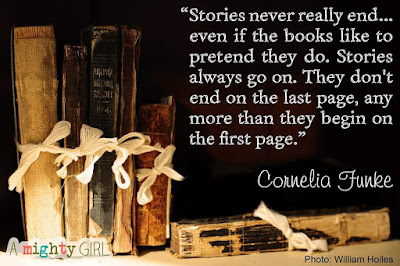
You may remember, I have a cat. His name is Apollo. I met him when he was six months old. He was staying at a rescue home at the time, and didn't like it. I didn’t want a cat, much less a rambunctious kitten. But he was quite persuasive. I never had a chance.
So Apollo took me home, where he met Comma. Comma took to him immediately. The three of us took great care of each other.
Some time ago, Comma had to leave us. He had always been small and sickly. Neither Apollo nor I wanted him to go, but Comma was the wisest of us, and knew better.
So, it was just me and Apollo, together. A family for many years. Not sure when or how it happened, actually, when one day he couldn’t walk as he once ran. He developed kidney disease, and diabetes. Then he told me it was time for him to leave. He missed Comma, too.
I argued, of course. But he could be quite persuasive.
On Sept. 1, Apollo joined Comma. We had been together for seventeen years. I’ve been quite discombobulated ever since, and couldn’t find a story to share.
As it happens, inspiration – or solace, whatever is needed in the moment – comes from this reminder how important your story is.
About the image: For more inspiration about A Mighty Girl, see their blog at A Mighty Girl.
Thank you for reading.
-- Bobbi Miller
September 14, 2022
What do crocheted slippers and Tom Selleck have in common? The answer is an amazing teacher! By: Jennifer Mitchell
I grew up in Independence, Missouri (the hometown of Harry S Truman). I attended school K-12 in the Independence School District, of which I have now worked for since the age of eighteen. Though I had a fondness for several of my teachers throughout my educational journey, my sixth grade teacher stands out in my mind the most. At that time sixth grade was still part of the elementary school, currently in our district 6th grade is now considered middle school though. I feel like sixth grade can be a pivotal year, you feel like you are getting older and more mature, but you are still awkward and need to be a kid. That year being an 80’s kid we had three Jennifer’s in that class. My nickname became Jenni (referred to as Jenni with an i) that is the only time in life I have gone by Jenni and somehow it worked and was endearing. My sixth grade teacher was that fine mix between showing students how much she cared about them, and being able to lay down the law when necessary.
To paint a picture of this marvelous teacher you first have to visualize crocheted slippers, once her feet started to hurt during the day those were a staple she switched to. As well as multiple posters, calendars and photos of Tom Selleck as Magnum P.I. She was probably in her late 20’s early 30’s at that time, was single, and not afraid to open her teacher’s cabinet letting all of us in on her clear obsession of Tom. At that point she became a relatable person to all of us, she wasn’t just a teacher, she was a person too. Back in the 80’s most teachers didn’t work very hard at letting students know they were human. :)
Beyond being able to connect with her students, she brought to life some magical literature. I was introduced to A Secret Garden, A Little Princess, From the Mixed up Files of Mrs. Basil E. Frankweiler, and other great novels that sparked great discussion. Through these books, I gained a love of different genres. It was also fun to talk with her about books I was reading at home, and make connections. As a student I felt like she really was interested in me, and what I was sharing. I think that is what most people remember about teachers they are fond of, how they made us feel, and if we were valued. It also never hurt that on Fridays when we passed papers back from the week she would give us round sour candies. I am pretty sure they weren’t all that tasty, but we lived for the sound of the plastic bag being cut open so they could be handed out.
I strive to be “that” teacher for my own students. I am there to provide students with an education, but I also want to make learning fun, and give them memories. Sometimes it is the little things that resonate with students, things teachers have no idea they will remember for years to come.

by: Jennifer Mitchell 3rd grade teacher in the Kansas City area
September 12, 2022
Back To School: A Tale of Old by Darlene Beck jacobson
In keeping with our September theme of favorite teachers and funny stories about school, and because historical fiction is one of my genres, I thought I'd take you on a trip in the time machine. Back to the days of my own school beginnings.
Growing up during the depression, my mom, like many of her generation, saved everything. When I say everything, I mean, she even saved my report cards! Here's the one from Kindergarten 1957-58:
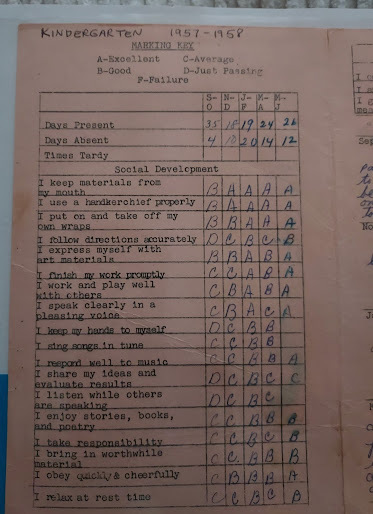
Before you pass judgement on my appalling attendance (I was mom's first born and every time I had a sniffle or suspicious ailment, she kept me home. YES... I was sick a lot). Notice instead the things we got graded on.
- using a hanky properly
- keeping ones hands to oneself
- taking responsibility
- speaking clearly in a pleasing voice
- obeying quickly and cheerfully
- enjoying stories, books, and poetry
- working and playing well with others
Of course life was a lot less complicated then. But doesn't it seem that these simple actions still have value? I will leave it up to you to decide whether or not these "old-fashioned" values have any use in today's world. Maybe we don't have time to teach such mundane things anymore. Too many other things are far more important.
Some things were scary for kids back then as they can sometimes be today.
Like CIVIL DEFENSE:

"Duck and Cover" drills were a part of everyday life thanks to the COLD WAR. Stocking up on basics in case...of what? I remember being scared every time the air raid siren went off (practice drills). Wondering if this was when the bomb would drop.
Hardly simple and no less scary than the active shooter drills school kids face today.
We worried about whether or not we should have our kids vaccinated (against polio instead of Covid).
It's tempting to think things were better back in the "good old days". Things were different; but we have always faced uncertainty, scary threats from unknown sources, and constant change.
In the old days, learning to read and write was taught with the help of Dick, Jane, Sally, Spot, and Puff, the Scott Forsman Readers that taught my generation how to be literate. Books were portals to untold adventures then and they are the same now, providing not only education, enlighentment, but also comfort and reassurance that we are not alone in our fears or anxieties.
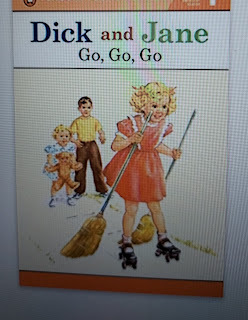 While much about school has changed, for many kids it is still a welcome and nurturing place where they can learn all the basics...and maybe some of the other stuff too.
While much about school has changed, for many kids it is still a welcome and nurturing place where they can learn all the basics...and maybe some of the other stuff too.For me, school was a safe and caring place to be. I hope that it is for today's generation of children.
Darlene Beck Jacobson learned to like school so much, she became a teacher. Now retired, she still gets excited wandering around Staples or Target, looking for back to School supplies.
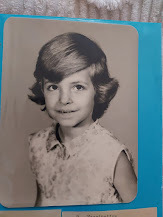
September 11, 2022
It Started in 1st Grade
 Not Miss Gabriel, but close enoughLooking back, it must have been one of those days when our first-grade teacher, Miss Gabriel, needed a minute to breathe. Although she was known for a spirit as fiery as her red hair, which could strike fear in the minds of all her students, there was an underlying kindness; even a love for every one of us. So, on that day when, on the black(green)board, she chalked in a problem for us to solve, "alone and quiet at our desks," I set to work. I don't remember the specifics of the problem, but it had to do with Farmer Jones planting corn, beans, and wheat. Our task: Figure out how many rows of crops Farmer Jones planted in all. I sat there for a minute--maybe two or three--and I knew the answer was 10.
Not Miss Gabriel, but close enoughLooking back, it must have been one of those days when our first-grade teacher, Miss Gabriel, needed a minute to breathe. Although she was known for a spirit as fiery as her red hair, which could strike fear in the minds of all her students, there was an underlying kindness; even a love for every one of us. So, on that day when, on the black(green)board, she chalked in a problem for us to solve, "alone and quiet at our desks," I set to work. I don't remember the specifics of the problem, but it had to do with Farmer Jones planting corn, beans, and wheat. Our task: Figure out how many rows of crops Farmer Jones planted in all. I sat there for a minute--maybe two or three--and I knew the answer was 10. Being the shy, quiet student who never wanted to make waves, I probably sat for another minute, working up the courage to disturb Miss Gabriel. I finally tiptoed up to her desk, and she looked down at me, as in, "Now what?"
"Can I help you?" she said."I think the answer is ten.""How did you come up with that?""I don't know."
Then I tried to explain my thought process, which was probably no explanation at all, or maybe enough of one, because her whole demeanor changed.
She pulled out a piece of paper, drew three interconnecting circles, and by showing me my first Venn diagram, she unraveled the explanation that, seconds ago, remained jumbled in my mind.
Before that moment, I might have enjoyed such challenges, but thinking back...
That look of surprise on her face and the care she took in teaching me a bit of math flipped a puzzle-switch in me. From then on, I craved riddles, rebuses, logic problems--any means of puzzles.
Ah, Miss Gabriel! I only wish youhad been around when I figured out a way to turn that craving into The Gollywhopper Games.
Jody Feldman is keeping this part of the bio short because she needs to finish the three-star crossword puzzle sitting and staring at her.
September 8, 2022
THE WORST BEST SCHOOL YEAR OF MY LIFE
This is my grade school. I went there from kindergarten through 8th grade. I had many good teachers, even a few great ones. One year stands out from the rest. It was the worst year of my life. And so I owe it everything.
My 4th grade teacher’s name was Miss Headblad. As with a Charles Dickens character, I probably don’t need to tell you any more than that. She made us copy entries from an old encyclopedia. I can’t remember if this was supposed to be education or punishment. Probably both. I had no friends in the class. They all got sent to a brand new school on the other side of town. The kids who were not my friends remained.
Everyone gets bullied. Even bullies have been made miserable by other humans. I now know that what happened to me was much milder than what happened to others. But at the time, I seemed to be the only one in my class who was targeted. The school bus ride was the worst part of my day. And when the ride ended, my main tormentor got off at my stop too. We were neighbors. We had been friends. That made it worse.
To avoid her – I took the long way home through the woods.

I scrambled down the side of the ravine, walked along the creek, and meandered among the trees until I was ready to come up again in the safety of my own back yard. Ready to answer my mom's question. "How was school?" Fine.
Because at that point I was fine. Being in the woods had comforted me. It still does. I was by myself, but I wasn’t alone. There were stories to be found in each hollow log. I had space to examine my feelings. To wonder why people acted the way they did. And eventually to imagine the feelings of others.
Fourth grade was the worst year of my life. But in that year, I learned the power of empathy and endurance. I learned that nature will nurture. I learned that people won't always be kind. That was okay. I learned I could escape into stories––created by me or by others.
And I didn't copy any of that out of an encyclopedia.
Jane Kelley was inspired by her hours in that woods to write her first novel, NATURE GIRL.
@font-face {font-family:"Cambria Math"; panose-1:2 4 5 3 5 4 6 3 2 4; mso-font-charset:0; mso-generic-font-family:roman; mso-font-pitch:variable; mso-font-signature:3 0 0 0 1 0;}@font-face {font-family:Calibri; panose-1:2 15 5 2 2 2 4 3 2 4; mso-font-charset:0; mso-generic-font-family:swiss; mso-font-pitch:variable; mso-font-signature:-536859905 -1073732485 9 0 511 0;}p.MsoNormal, li.MsoNormal, div.MsoNormal {mso-style-unhide:no; mso-style-qformat:yes; mso-style-parent:""; margin:0cm; mso-pagination:widow-orphan; font-size:12.0pt; font-family:"Calibri",sans-serif; mso-ascii-font-family:Calibri; mso-ascii-theme-font:minor-latin; mso-fareast-font-family:Calibri; mso-fareast-theme-font:minor-latin; mso-hansi-font-family:Calibri; mso-hansi-theme-font:minor-latin; mso-bidi-font-family:"Times New Roman"; mso-bidi-theme-font:minor-bidi;}p.Prose, li.Prose, div.Prose {mso-style-name:Prose; mso-style-unhide:no; margin:0cm; text-indent:36.0pt; line-height:200%; mso-pagination:widow-orphan; font-size:12.0pt; font-family:"Times New Roman",serif; mso-fareast-font-family:Calibri; mso-fareast-theme-font:minor-latin; mso-bidi-font-family:"Times New Roman"; mso-bidi-theme-font:minor-bidi; mso-ansi-language:EN-US;}.MsoChpDefault {mso-style-type:export-only; mso-default-props:yes; font-family:"Calibri",sans-serif; mso-ascii-font-family:Calibri; mso-ascii-theme-font:minor-latin; mso-fareast-font-family:Calibri; mso-fareast-theme-font:minor-latin; mso-hansi-font-family:Calibri; mso-hansi-theme-font:minor-latin; mso-bidi-font-family:"Times New Roman"; mso-bidi-theme-font:minor-bidi;}div.WordSection1 {page:WordSection1;}
@font-face {font-family:"Cambria Math"; panose-1:2 4 5 3 5 4 6 3 2 4; mso-font-charset:0; mso-generic-font-family:roman; mso-font-pitch:variable; mso-font-signature:3 0 0 0 1 0;}@font-face {font-family:Calibri; panose-1:2 15 5 2 2 2 4 3 2 4; mso-font-charset:0; mso-generic-font-family:swiss; mso-font-pitch:variable; mso-font-signature:-536859905 -1073732485 9 0 511 0;}p.MsoNormal, li.MsoNormal, div.MsoNormal {mso-style-unhide:no; mso-style-qformat:yes; mso-style-parent:""; margin:0cm; mso-pagination:widow-orphan; font-size:12.0pt; font-family:"Calibri",sans-serif; mso-ascii-font-family:Calibri; mso-ascii-theme-font:minor-latin; mso-fareast-font-family:Calibri; mso-fareast-theme-font:minor-latin; mso-hansi-font-family:Calibri; mso-hansi-theme-font:minor-latin; mso-bidi-font-family:"Times New Roman"; mso-bidi-theme-font:minor-bidi;}p.Prose, li.Prose, div.Prose {mso-style-name:Prose; mso-style-unhide:no; margin:0cm; text-indent:36.0pt; line-height:200%; mso-pagination:widow-orphan; font-size:12.0pt; font-family:"Times New Roman",serif; mso-fareast-font-family:Calibri; mso-fareast-theme-font:minor-latin; mso-bidi-font-family:"Times New Roman"; mso-bidi-theme-font:minor-bidi; mso-ansi-language:EN-US;}.MsoChpDefault {mso-style-type:export-only; mso-default-props:yes; font-family:"Calibri",sans-serif; mso-ascii-font-family:Calibri; mso-ascii-theme-font:minor-latin; mso-fareast-font-family:Calibri; mso-fareast-theme-font:minor-latin; mso-hansi-font-family:Calibri; mso-hansi-theme-font:minor-latin; mso-bidi-font-family:"Times New Roman"; mso-bidi-theme-font:minor-bidi;}div.WordSection1 {page:WordSection1;}
September 7, 2022
Interview with Kathleen Wilford, Author of Cabby Potts, Duchess of Dirt
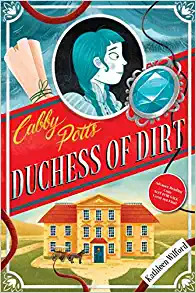 Gotta start with the elevator pitch: Tell us about Cabby Potts, Duchess of Dirt in one sentence. A sod house, a grand manor. A mystery, a matchmaking scheme. A tale of the prairie with humor and heart and a touch of romance. (I know that’s three sentences!) Anytime I see historical fiction, I figure there has to be some kind of backstory about the inspiration. What brought you to this topic? I ran across a book called Prairie Fever, by Peter Pagnamenta, and I was intrigued to learn about the British aristocracy’s fascination with the American West. Cabby Potts, Duchess of Dirt is based on the true story of Victoria, Kansas, an enclave of British aristocrats in the 1870’s. Victoria was designed as a “community of culture and refinement” where “the arts and graces of life” could be imported straight from London. I couldn’t imagine a bigger culture clash than between the English nobility and hardscrabble American homesteaders. I pictured an outdoorsy 12-year-old girl forced to work as a housemaid at a grand English manor, and the character of Cabby was born. Trying to save her family’s struggling homestead, Cabby plays matchmaker between her pretty, romantic sister Emmeline and the rich young lord of Ashford Manor. What could go wrong with that scheme? I love the pacing of the Duchess of Dirt. By page 11, we already know about Cabby’s family’s money problems, we see her at her new job, and we meet Lord Ashford. The main elements of the novel are there really quickly–the reader doesn’t have to wait for them. Did you find it difficult to maintain that kind of quick pacing throughout? Thanks for saying that, Holly. I wanted to grab readers right away and keep them turning pages. I trust I succeeded. Plotting is always a labor of love for me, since I don’t make a detailed outline, so the book went through many revisions. What was your research like? Did you find out something that completely surprised you? I like to begin with books that situate the time period I’m studying in a larger historical context. I follow that up with more specific books and then with primary sources. For Cabby Potts, Duchess of Dirt, I consulted homesteader journals, 1870’s editions of the Dodge City Times, an 1841 book by Dr. Samuel Sheldon Fitch called Diseases of the Chest (fascinating, trust me), Mrs. Beeton’s book on the duties of a housemaid . . . etc.! Since I work for Rutgers, I’m lucky enough to have access to the rich depth of primary materials owned by the university. As for things that surprised me, how much time do we have?? I learned so many fascinating tidbits of information, many of which I couldn’t include in the book but would be happy to tell you about sometime. Some facts that DID make it into the book: people used to believe that walking on the prairie could cure consumption (tuberculosis)—housemaids were not allowed to whistle in the house—dried up buffalo dung was burned for fuel! One surprising fact that informed my book: fully half of all homesteaders didn’t make it and never “proved up” on their claims. We tend to romanticize homesteading on the prairies, but it was brutally difficult. Smack Dab’s followers are frequently writers themselves. Any tips for balancing fact and fiction for the young audience? Maybe the most important thing I kept in mind: historical fiction is fiction FIRST. Include facts only as they serve to advance the story or illuminate character, emotion or atmosphere. Otherwise, it’s nonfiction. What do you love about this period of history? I’ve always been fascinated by pioneer literature, from Willa Cather to Laura Ingalls Wilder. My life is so easy compared to women who endured life on lonely prairies, living in sod houses and struggling to keep themselves and their families alive. I have to say, I love that Cabby’s a housemaid–especially considering the struggle so many parents have getting their kids to keep a single room clean! Did that play into your choices here? Ha, ha, I never considered inspiring kids to clean their rooms! But I’m an outdoor kind of person myself and would much rather mow the lawn than vacuum my house. So I sympathize with Cabby. I love your language throughout: phrases like “scolding mood” that give the book a historical feel. But at the same time, Cabby might also shout out “Hey!” which makes the historical setting feel not so far away. Other than overall tone, how do you make an era so long gone feel vibrant and important to young readers? I think young readers enjoy immersing themselves in a different world or time period, and part of that is language. Reading a lot of primary sources helped me find my tone and dialect. I hope readers will get a kick out of the contrast of dialect between, say, Lady Ashford and Bub Skyler, who uses words like “hornswoggling,” which means deceitful. At the same time, as you say, authenticity has to be balanced with relatability. You include so many topical issues: haves and have-nots, some racial issues (Cabby’s Native American friend)--so often, historical fiction tells us more about who we are now. What current messages do you hope young readers take away from Cabby’s story? I hope kids will enjoy a funny, fast-paced story with lots of drama! Beyond that, I hoped to give readers a clearer picture of the homesteading life. Along with showing how difficult the life was, I wanted readers to see how race and class prejudices infiltrated even supposedly egalitarian rural America. Cabby wakes up to this prejudice as she forms a friendship with Eli, a half-Kiowa boy. She finally learns to use her “intemperate tongue” to stand up for him, her family, and her whole community. In Cabby Potts, I tried to portray a funny, feisty girl growing into more awareness of her world, with all its imperfections. She learns to use her voice to make that world a better place, something I hope we all can do. What’s next? I have some irons in the fire, but they’re pretty unformed at this point. Short bio:
Gotta start with the elevator pitch: Tell us about Cabby Potts, Duchess of Dirt in one sentence. A sod house, a grand manor. A mystery, a matchmaking scheme. A tale of the prairie with humor and heart and a touch of romance. (I know that’s three sentences!) Anytime I see historical fiction, I figure there has to be some kind of backstory about the inspiration. What brought you to this topic? I ran across a book called Prairie Fever, by Peter Pagnamenta, and I was intrigued to learn about the British aristocracy’s fascination with the American West. Cabby Potts, Duchess of Dirt is based on the true story of Victoria, Kansas, an enclave of British aristocrats in the 1870’s. Victoria was designed as a “community of culture and refinement” where “the arts and graces of life” could be imported straight from London. I couldn’t imagine a bigger culture clash than between the English nobility and hardscrabble American homesteaders. I pictured an outdoorsy 12-year-old girl forced to work as a housemaid at a grand English manor, and the character of Cabby was born. Trying to save her family’s struggling homestead, Cabby plays matchmaker between her pretty, romantic sister Emmeline and the rich young lord of Ashford Manor. What could go wrong with that scheme? I love the pacing of the Duchess of Dirt. By page 11, we already know about Cabby’s family’s money problems, we see her at her new job, and we meet Lord Ashford. The main elements of the novel are there really quickly–the reader doesn’t have to wait for them. Did you find it difficult to maintain that kind of quick pacing throughout? Thanks for saying that, Holly. I wanted to grab readers right away and keep them turning pages. I trust I succeeded. Plotting is always a labor of love for me, since I don’t make a detailed outline, so the book went through many revisions. What was your research like? Did you find out something that completely surprised you? I like to begin with books that situate the time period I’m studying in a larger historical context. I follow that up with more specific books and then with primary sources. For Cabby Potts, Duchess of Dirt, I consulted homesteader journals, 1870’s editions of the Dodge City Times, an 1841 book by Dr. Samuel Sheldon Fitch called Diseases of the Chest (fascinating, trust me), Mrs. Beeton’s book on the duties of a housemaid . . . etc.! Since I work for Rutgers, I’m lucky enough to have access to the rich depth of primary materials owned by the university. As for things that surprised me, how much time do we have?? I learned so many fascinating tidbits of information, many of which I couldn’t include in the book but would be happy to tell you about sometime. Some facts that DID make it into the book: people used to believe that walking on the prairie could cure consumption (tuberculosis)—housemaids were not allowed to whistle in the house—dried up buffalo dung was burned for fuel! One surprising fact that informed my book: fully half of all homesteaders didn’t make it and never “proved up” on their claims. We tend to romanticize homesteading on the prairies, but it was brutally difficult. Smack Dab’s followers are frequently writers themselves. Any tips for balancing fact and fiction for the young audience? Maybe the most important thing I kept in mind: historical fiction is fiction FIRST. Include facts only as they serve to advance the story or illuminate character, emotion or atmosphere. Otherwise, it’s nonfiction. What do you love about this period of history? I’ve always been fascinated by pioneer literature, from Willa Cather to Laura Ingalls Wilder. My life is so easy compared to women who endured life on lonely prairies, living in sod houses and struggling to keep themselves and their families alive. I have to say, I love that Cabby’s a housemaid–especially considering the struggle so many parents have getting their kids to keep a single room clean! Did that play into your choices here? Ha, ha, I never considered inspiring kids to clean their rooms! But I’m an outdoor kind of person myself and would much rather mow the lawn than vacuum my house. So I sympathize with Cabby. I love your language throughout: phrases like “scolding mood” that give the book a historical feel. But at the same time, Cabby might also shout out “Hey!” which makes the historical setting feel not so far away. Other than overall tone, how do you make an era so long gone feel vibrant and important to young readers? I think young readers enjoy immersing themselves in a different world or time period, and part of that is language. Reading a lot of primary sources helped me find my tone and dialect. I hope readers will get a kick out of the contrast of dialect between, say, Lady Ashford and Bub Skyler, who uses words like “hornswoggling,” which means deceitful. At the same time, as you say, authenticity has to be balanced with relatability. You include so many topical issues: haves and have-nots, some racial issues (Cabby’s Native American friend)--so often, historical fiction tells us more about who we are now. What current messages do you hope young readers take away from Cabby’s story? I hope kids will enjoy a funny, fast-paced story with lots of drama! Beyond that, I hoped to give readers a clearer picture of the homesteading life. Along with showing how difficult the life was, I wanted readers to see how race and class prejudices infiltrated even supposedly egalitarian rural America. Cabby wakes up to this prejudice as she forms a friendship with Eli, a half-Kiowa boy. She finally learns to use her “intemperate tongue” to stand up for him, her family, and her whole community. In Cabby Potts, I tried to portray a funny, feisty girl growing into more awareness of her world, with all its imperfections. She learns to use her voice to make that world a better place, something I hope we all can do. What’s next? I have some irons in the fire, but they’re pretty unformed at this point. Short bio:
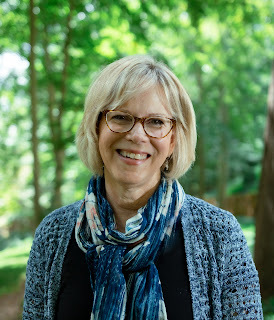
Kathleen Wilford was born in Panama and has lived in four different countries and three different states—but never in Kansas. She studied literature at Cornell University and at Rutgers University in New Jersey, where she now teaches writing. When she’s not teaching or writing, Kathleen can be found outdoors, chasing her disobedient dog. Cabby Potts, Duchess of Dirt is Kathleen’s debut novel for kids. Connect with Kathleen at https://www.kathleenwilford.com/ On Twitter: https://twitter.com/kathwilford Ordering info is on my website or: Amazon: https://www.amazon.com/Cabby-Potts-Du... Or at my local bookstore: https://bookwormbernardsville.indieli...
September 4, 2022
Chalk Art Manga and Manga Art: How-To Books Unlike Anything Else on the Market (Danica Davidson)
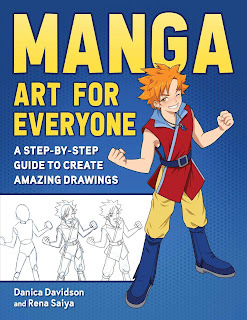
I have eighteen books out now, but before I sold any of my books, I was working as a journalist covering manga and anime. This came out of my love of the medium, which really took off while I was a teenager. It was writing about anime and manga that actually led me to selling my first book — Manga Art for Beginners — and this past summer, I’ve come out with two new manga how-to-draw books.
For both of these, I worked with Rena Saiya, a bilingual Japanese manga creator who also wants to publish abroad. I found her on LinkedIn, if you believe it, and we’ve been working together ever since.
The first book, Manga Art for Everyone, is a sequel to Manga Art for Beginners. Manga Art for Beginners starts out showing how to draw different body parts (eyes, faces, hair) and then overall anatomy (the form of the body) then moves on to drawing different character types. One of my frustrations with other how-to-draw books is that they don’t show enough steps. That’s why with each of these manga books, the steps are laid out in great detail, so that people can really follow what happens.
With the sequel, Manga Art for Everyone, we don’t show the introduction on drawing body parts, but we do open with details on how manga is made in Japan. That means it discusses the pens, the software, the ways mangaka (manga creators) create shine and put on screentone. Then it goes on to show how to create seventeen different characters, including a shojo heroine, a shonen hero (you see him on the cover), a female warrior, a bride and groom, a Victorian Man, and some yokai (Japanese legendary creatures).
The second book, Chalk Art Manga, is unlike anything else out there. Do you love manga? Do you love (or loved as a kid) creating chalk art on your sidewalk or driveway? Then this book is for you: the first-ever book on how to draw manga-style characters using chalk art.
Like Manga Art for Beginners and Manga Art for Everyone, Chalk Art Manga breaks down the steps so you can follow what is happening. The artwork also ranges from very simple (like the smiling sushi) to more complex. Chalk art also lets you go wild with colors, so we have pink-haired girls and brightly colored kawaii candy. The last drawing is a Harajuku Girl, which references the vibrant Harajuku fashion in Japan.
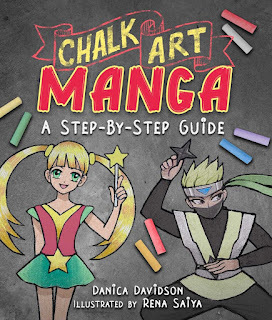
There’s also a ninja, a magical girl, two chibi characters, a T-Rex and a unicorn. Chalk Art Manga is meant for fans of all ages and all art skills, so you can start at the beginning and work your way up.
With Manga Art for Everyone and Chalk Art Manga, you can bring manga characters to life on your notebook, on your screen, or on your pavement. That’s a lot of manga characters!
Snag a copy of Chalk Art Manga here!
September 2, 2022
Teacher of My Dreams
Teacher of My Dreams
Madame Nettie Kitzes, my high school French teacher, was a force of nature. Terrifying yet improbably kind at times, she haunted my dreams for decades. “Sortez une feuille de papier!” she would announce at random moments, meaning that we needed to take out a piece of paper and prepare for a pop quiz that we might or might not be ready for. My dreams usually revolved around moments when I was decidedly not ready.
One year, she had us perform a play called Topaze, by Marcel Pagnol, which took place at a boarding school. Because I was incredibly shy and quiet, she gave me the role of a student who falls asleep at her desk. No words required, as Madame Kitzes felt no one in the audience would be able to hear me anyway. I also was put in the back row with the boys during the scene where we danced the Charleston. Theater was not my thing.
She prepared us for the AP exam with a ferocity that paid off, and encouraged our creativity with art projects. I still remember making collages depicting poems by Mallarmé, Baudelaire, and others, with—of course—complete accuracy required in the transcriptions of the poets’ words. One year, when I was removed from Madame Kitzes’s class due to its being overcrowded, and unceremoniously dumped into another French teacher’s room, I cried.
But perhaps the most unforgettable memory was when Madame Kitzes had us memorize a soliloquy from Cyrano de Bergerac, in which Cyrano declaims, at length, upon the hugeness of his nose. Imagine, if you will, a teenage girl with what was euphemistically known as “large features,” a girl who wanted nothing more than to disappear into the walls of the room and not be noticed, having to get up in class and discuss such a topic. “My nose is like a peninsula!” the soliloquy went (in French). “My nose is like an elephant’s trunk!”
So each day, a few students were called up to the front of the room to perform the soliloquy. Then we’d go on to other things. And during this time, as I recall, we had a remarkably large number of fire drills, which delayed the performances further. I’d be standing outside the C Building, staring at the brick walls and thinking, “My nose is like a peninsula!” I’d practice in the shower, on the bus to school, wherever I might be. “My nose is like an elephant’s trunk!” While I remember the buildup very well—I was one of the last students called upon, so this process went on interminably--my actual performance has sunk into the mists of time.
But Madame Kitzes, who passed away in 2017 at the age of 97, will live on in my mind forever.
--Deborah Kalb
@font-face {font-family:"Cambria Math"; panose-1:2 4 5 3 5 4 6 3 2 4; mso-font-charset:0; mso-generic-font-family:roman; mso-font-pitch:variable; mso-font-signature:3 0 0 0 1 0;}@font-face {font-family:Calibri; panose-1:2 15 5 2 2 2 4 3 2 4; mso-font-charset:0; mso-generic-font-family:swiss; mso-font-pitch:variable; mso-font-signature:-536859905 -1073732485 9 0 511 0;}p.MsoNormal, li.MsoNormal, div.MsoNormal {mso-style-unhide:no; mso-style-qformat:yes; mso-style-parent:""; margin:0in; mso-pagination:widow-orphan; font-size:16.0pt; font-family:"Times New Roman",serif; mso-fareast-font-family:Calibri; mso-fareast-theme-font:minor-latin;}.MsoChpDefault {mso-style-type:export-only; mso-default-props:yes; font-size:16.0pt; mso-ansi-font-size:16.0pt; mso-bidi-font-size:16.0pt; mso-fareast-font-family:Calibri; mso-fareast-theme-font:minor-latin;}div.WordSection1 {page:WordSection1;}
September 1, 2022
August 29, 2022
On Your Mark, Get Set...Start!
by Charlotte Bennardo
What does it take to get started? For painting the dining room (which I've put off for two years) it was scheduling time so I had to do it. For doing my MFA homework, it was sitting down at my desk in my office away from all distractions. For starting a new writing project?
 photo by Tembela Bohle, Pexels
photo by Tembela Bohle, Pexels
All it takes is the spark of an idea.
A bit on conversation overhead in a store.
A trivial fact read on social media.
An idea taken from a well-known story, but from a completely different angle.
Asking the question.... What if?
For me the problem is never the getting started, or even finishing, but working through the middle. Getting started is easy because when that idea hits you like a slap upside the head, you can't wait to start writing (authors call it a 'new shiny'). It almost drags you away from other stories where you're stuck in the middle or trying to work in the best ending.
Starting the race is easy; it's dragging your body across the finish line. So the question might, for me, be better phrased as "What does it take to get started on finishing that project?"
The best way to get started:
1- Make a list of what needs to be done first: schedule time block, gather materials, etc.
2- Have a clear idea of what needs to be done: a preliminary or even a detailed outline (that could be your starting point).
3- Give yourself permission to stop after a certain amount of the work is done, but leave a few notes on where you'll be going with the next sentences/paragraph/page/chapter.
4- Don't expect instant perfection if it's a work in progress (unless you're painting the dining room walls, it should be as perfect as you can make it. You don't want to have to do it again!)
5- Give yourself a schedule so that you don't step away from your start for too long.
Charlotte writes MG, YA, NA, and adult novels in sci fi, fantasy, contemporary, and paranormal genres. She is the author of the award-winning middle grade Evolution Revolution trilogy, Simple Machines, Simple Plans, and Simple Lessons. She co-authored the YA novels Blonde OPS, Sirenz, and Sirenz Back in Fashion. She has two short stories in the Beware the Little White Rabbit (Alice through the Wormhole) and Scare Me to Sleep (Faces in the Wood) anthologies. Currently she is working on several novels for both children and adults, and her MFA. She lives in NJ with her family and two demanding cats. When they trimmed the backyard tree, the crazy squirrel couple had to move out.




